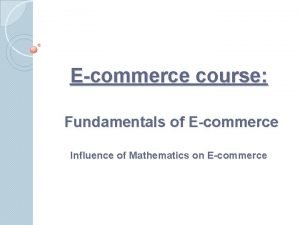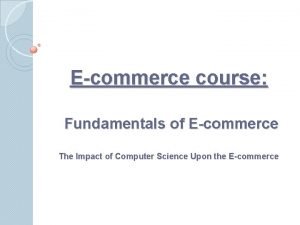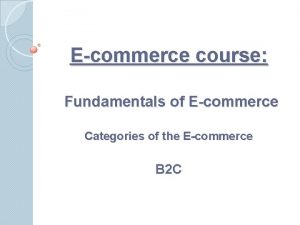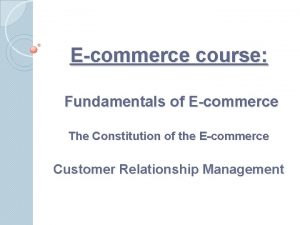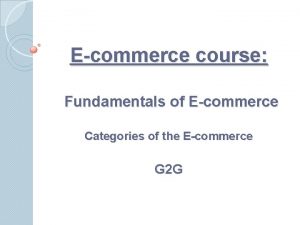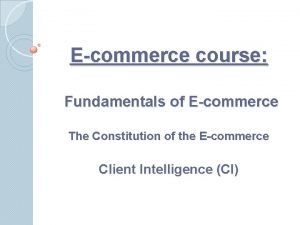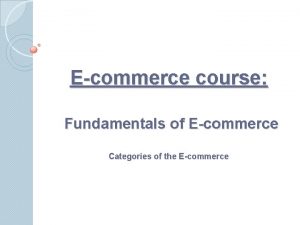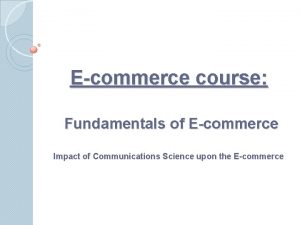Ecommerce course Fundamentals of Ecommerce The Definitions of









![Refrences [1] Qin Z. , Li S D. An Compendium to E-Commerce. Beijing: Higher Refrences [1] Qin Z. , Li S D. An Compendium to E-Commerce. Beijing: Higher](https://slidetodoc.com/presentation_image_h2/5a582eb281a30e850aad0dea51916dd7/image-10.jpg)
- Slides: 10

E-commerce course: Fundamentals of E-commerce The Definitions of E-commerce

The Definitions of E-commerce As the term suggests, e-commerce refers to various online commercial activities focusing on commodity exchanges by electronic means, Internet in particular, by companies, factories, enterprises, industrial undertakings and consumers. A large number of well-known organizations and corporations also have their own definitions on e-commerce. For example, ISO defines e-commerce as: it is the general term for exchange of information among enterprise and between enterprise and customers; the Global Information Infrastructure Committee defines it as the economical activities using electrical communications, with which people can purchase products, advertise goods and settle.

The following are definitions given by transnational corporations Intel, IBM and HP respectively. Intel: E-commerce = electronic market + electronic trade + electronic service IBM: E-commerce = information technology + web + business HP: E-commerce is to accomplish commercial business by electronic means. Since e-commerce is a brand new science, it is not at all surprising that there are various definitions about it. In addition, a premature uniform definition of e-commerce may slow the development of e-commerce. Ecommerce shall be social, economic activities between social principal parts by taking advantages of computers and network.

The implication of e-commerce: it refers to commercial trade activities carried out by electronic methods, the electronicization of traditional trades. The electronic means refer to electronic technologys, tools, equipments and systems, including telephone, telegram, television, facsimile, E-mail, electronic data interchange, computer, the communication network, credit card, electronic money and Internets. Commercial activities comprise inquiry, offer, negotiation, contract signing, contract fulfillment, payment. In a narrow sense, e-commerce refers to various online commercial activities focusing on commodity exchanges by electronic methods, computer network in particular, by companies, factories, enterprises, industrial undertaking and consumers.

In a broad sense, electronic business (EB) refers to the electronicization of all business among all industries (including governments, enterprises, and institutional units), such as electronic government, electronic command, electronic education, electronic public business, electronic household etc. Components of e-commerce are illustrated in the following Figure.

(1) Network: It includes Internet, Intranet, and Extranet. Internet is the foundation of e-commerce and the carrier of commercial business information. As to Intranet, it means for enterprises to carry out internal affairs. With regard to Extranet, it is the link between enterprises and users to carry out commercial activities. (2) E-commerce user. It includes personal consumers and business consumers. The business consumer scientifically manages staff, wealth, goods, production, supply and sales by Intranet, Extranet and MIS. Personal consumer has access to information and purchases goods by connecting Internet with browsers, set-top boxes, PDA (the personal digital assistance), Visual TV etc.

(3) Authentication Authority: The authentication Authority (CA), the authority recognized by law, is responsible for issuing, managing digital certificates and facilitating parties involved in online sales to identify each other. (4) Distribution center. It is in charge of sending goods that cannot be delivered on line to consumers and keeping track of goods flow. (5) Online bank. It provides the sellers and buyers the traditional bank business, such as settlement, and round-the-clock service. (6) The administration of the commercial activity. It consists mainly of departments of industry, customs, tax and trade.

The Significance of e-concept E-mail, called the Internet Killer User, attracts people to pay attention to the existence of the network, and sparks the rush of network gradually. E-mail transforms from receiving and sending e-mails to commercial use and becomes one of the principal tools for people to communicate on line. The e -wallet and e-cash etc. basically make it possible for people transfer fund on line and accordingly makes network and real life fuse further. The ecommerce has on a large scale began to impact the traditional pattern of trade and brought about intense changes of life style. It can be predicted that in future new concepts will spring up and the combination of electronic technologys and other ideas will give rise to new things, because electronic technology based on Internet is advancing continuously. “e-concept”, proposed in early 2000, is accepted and spreads quickly.

That is to say, e-concept is a new thing taking electronic and network technology as foundation, other technologies and ideas as platform of upper level. After double integration with other technologies and ideas, e-concept will exert a great impact on social life style. In this sense, e-commerce is just a subset of e-concept. E-commerce gives impetus to the development of society and provides broad space for future, though it is merely a subset of e-concept. The development of e-commerce may transform the whole social operation regulations, so the e-concept will exert much more influence on the society, no matter in depth or in scope. The significance of e-concept lies in that it makes people grasp not only radical changes of new things but also the root of all changes brought by e-concept in e-times so as to promote greater social changes.
![Refrences 1 Qin Z Li S D An Compendium to ECommerce Beijing Higher Refrences [1] Qin Z. , Li S D. An Compendium to E-Commerce. Beijing: Higher](https://slidetodoc.com/presentation_image_h2/5a582eb281a30e850aad0dea51916dd7/image-10.jpg)
Refrences [1] Qin Z. , Li S D. An Compendium to E-Commerce. Beijing: Higher Education Press, 2001. [2] Qin Z. , Xie G T. , Li S D. , & Jia X L. ECommerce System Structure and System Design. Xi’an: Xi’an Jiaotong University Press, 2001. [3] Qin Z. , Han Y. & Yan L X. Computer System Intergration and E-commerce. Xi’an: Xi’an Jiaotong University Press, 2001. [4] Qin Z. , Wang Z M. & Bao F M. Design Practice of Virtual Network. Xi’an: Xi’an Jiaotong University Press, 2001. [5] Qin Z. , Liu X Y. & Wang LR. Case Study on E-commerce. Xi’an: Xi’an Jiaotong University Press, 2001. [6] Qin Z. , Wang Y L. , Zhang L. & Wei M T. Virtual Business Management. Xi’an: Xi’an Jiaotong University Press, 2001. [7] K. Laudon, C. Traver. E-Commerce: Business, Technology, Society (3 rd Edition). Prentice-Hall, Inc. NJ, USA. 2006. [8] William G. Page. Jr. A Handbook of Oracle 8/8 i Development and Application (the first edition) Beijing: Machinery Industry Press, 2000. [9] Wang Q. , Qiu R J. & Wang H W. The Design and Achievement of Client’s Information Management System. Information Techniques, Issue 7, 2000, & Issue 87, 2000, 1820. [10] F. Damanpour. E-business E-commerce Evolution: Perspective and Strategy. Managerial Finance. Vol. 27 (7): 16 -33, 2001. [11] Yu Z T. , Song L Z. Che W G. & Guo J Y. The Strategies of Database Techniques in Shopping Vehicles on Internet. Computer Application, No. 8, Vol (20), 2000, 6668. [12] W. David. E-commerce: Strategy, Technologies And Applications. TATA MCGRA, India, 2000. [13] Zhang C X. , Tang J G. & Xie Y F. The Establishment of Bamboo Product Information System Database and the Design of Information Inquiry Function. Journal of Najing Forestry University Sum No. 70, Volume 12, 1996. [14] Daniel I. Joshi, Pavel A. A Complete Collection of References for Java Programmers. (the first edition) Beijing: China Water Conservancy and Hydroelectricity Press, 1999. [15] E. Turban, C. Cohen, I. M. Copi et al. Introduction to E-Commerce. Pearson Education, NJ, USA, 2003. [16] Yen-Liang Chang, Chen, S. Chyun-Chyi Chen, I. Workflow process Definition and Their Applications in E-commerce. Multimedia Software Engineering, 2000. Proceedings. International Symposium on, 2000, 193200. [17] Weaver, A. C. Vetter, R. J. Whinston, A. B. Swigger, K. The future of E-commerce. Computer, Volume: 33 Issue: 10, Oct. 2000, 3031. [18] S. Korper, J. Ellis. The E-commerce Book: Building the E-empire. Morgan Kaufmann, San Fransisco, USA, 2001. [19] Bhaskaran, K. Jen-Yao Chung Das, R. Heath, T. Kumaran, S. Nandi, P. An E-business Integration & Collaboration Platform for b 2 b E-commerce. Advanced Issues of E-Commerce and Web-Based Information Systems, WECWIS 2001, Third International Workshop on, 2001, 120122. [20] A. Panagariya. E-Commerce, WTO and Developing Countries. World Economy, Vol. 23 (8): 959978, 2002. [21] Pi Y. On Technological Crime in the Field of Finance. Legal Science Review, 2000. [22] Qu X W. Crime on Internet and Its Containing. Legal Science Study, 2000. [23] Wang Y. A Brief Analysis on E-commerce Law Issues. Legal Science Review, 2000. [24] Wi J P. E-commerce in China: Problems and Their Countermeasures. China Computer Paper, 1999. [25] Venkatraman, Mahadevan; Singh, Munindar P. Verifying Compliance with Commitment Protocols. Autonomous Agents and Multi-Agent Systems; 13872532; No. 3 (2), 1999. [26] Shaw, Michael J. Electronic Commerce: Review of Critical Research Issues. Information Systems Frontiers; 13873326; No. 1 (1), 1999. [27] Garrett, S. G. E. ; Skevington, P. J. An Introduction to Electronic Commerce. BT Technology Journal; 13583948˗No. 3 (17), 1999. [28] Unitt, M. , Jones, I. C. EDI-The Grand Daddy of Electronic Commerce. BT Technology Journal; 13583948; No. 3 (17), 1999. [29] Trask, N. T. Meyerstein, M. V. Smart Cards in Electronic Commerce. BT Technology Journal; 13583948; No. 3 (17), 1999. [30] S. S. Y. Shim, V. S. Pendyala, M. Sundaram, J. Z. Gao, Business-to-Business E-Commerce Frameworks. Computer, vol. 33(10): 4047, 2000. [31] D. Kinyon. Quarterly retail ecommerce sales: 4 th quarter 2007. US Census Bureau News 2008, CB 08 -24. [32] A. K. Ghosh, T. M. Swaminatha. Software security and privacy risks in mobile e-commerce. Communications of the ACM, Vol. 44(2): 5157, 2001. [33] S. Hawk. A Comparison of B 2 C E-Commerce in Developing Countries. Electronic Commerce Research, Vol. 4(3): 181199, 2004. [34] Lu X D. Making and Implementing E-commerce Strategies with Chinese Characteristics. Dongyue Series, 2001(01): 6063. [35] Liu J. Key Points and Measures of E-commerce Strategies in Canana. Global Watch of Science and Technology and Economy, 2000(6): 1415. [36] Tian H. Japan Plans to Be the Most Advanced Country in IT within Five Years. East Web. [37] He D G. Catching up with and Surpassing America: the Dream of Japanese IT Revolution. Army Paper, May 16 th, 2002. [38] Japan Publicizes New IT Strategies of the Year 2002. People’s Daily, June 28 th. 2001. [39] A. Tsalgatidou, J. Veijalainen.
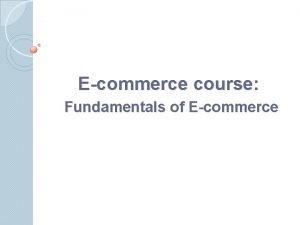


![[author] java message service - jms fundamentals course [author] java message service - jms fundamentals course](https://slidetodoc.com/wp-content/uploads/2020/09/381247_2ef7a792adac8a30d3544ffd2fa051e8-300x225.jpg)







